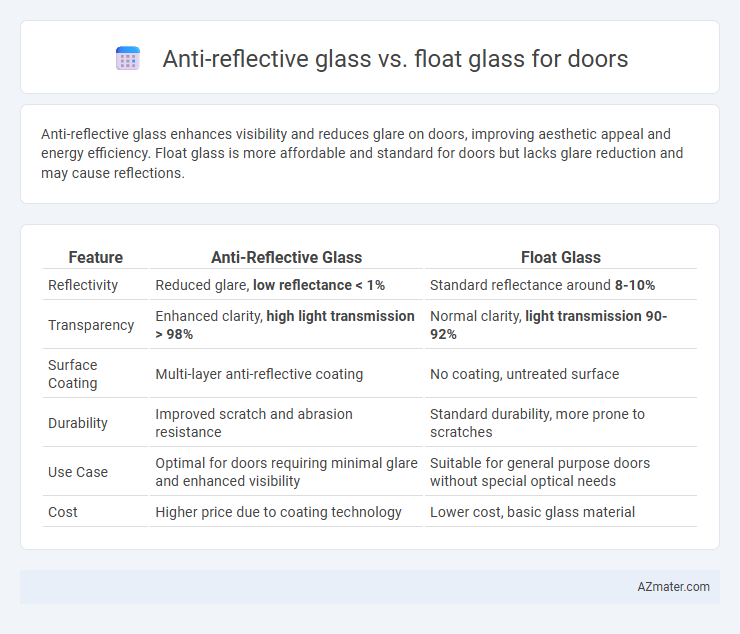Anti-reflective glass enhances visibility and reduces glare on doors, improving aesthetic appeal and energy efficiency. Float glass is more affordable and standard for doors but lacks glare reduction and may cause reflections.
Table of Comparison
| Feature | Anti-Reflective Glass | Float Glass |
|---|---|---|
| Reflectivity | Reduced glare, low reflectance < 1% | Standard reflectance around 8-10% |
| Transparency | Enhanced clarity, high light transmission > 98% | Normal clarity, light transmission 90-92% |
| Surface Coating | Multi-layer anti-reflective coating | No coating, untreated surface |
| Durability | Improved scratch and abrasion resistance | Standard durability, more prone to scratches |
| Use Case | Optimal for doors requiring minimal glare and enhanced visibility | Suitable for general purpose doors without special optical needs |
| Cost | Higher price due to coating technology | Lower cost, basic glass material |
Introduction to Anti-Reflective and Float Glass
Anti-reflective glass reduces surface reflections by using specialized coatings, enhancing visual clarity and light transmission, which makes it ideal for doors requiring high transparency and minimal glare. Float glass, produced by floating molten glass on a bed of molten metal, offers a smooth, uniform surface but lacks anti-glare properties, making it a basic, cost-effective choice for standard door applications. The key difference lies in the anti-reflective coating of anti-reflective glass that improves aesthetic appeal and user experience compared to the untreated surface of float glass.
What is Anti-Reflective Glass?
Anti-reflective glass features a specialized coating that minimizes glare and reflections by reducing surface reflectance to less than 1%, improving visibility and aesthetic clarity for doors. Unlike standard float glass, which is untreated and more prone to reflections and glare, anti-reflective glass enhances the transparency and visual appeal of door installations. This type of glass is ideal for environments requiring maximum light transmission and minimal visual distortion.
What is Float Glass?
Float glass is a type of flat glass made by floating molten glass on a bed of molten metal, typically tin, resulting in a smooth, uniform surface ideal for various applications, including doors. Unlike anti-reflective glass, which reduces glare and enhances visibility by minimizing reflections, float glass offers standard transparency and durability without specialized coatings. For doors, float glass provides a cost-effective, clear option that balances strength with aesthetic appeal but lacks the advanced optical properties of anti-reflective glass.
Key Differences Between Anti-Reflective and Float Glass
Anti-reflective glass reduces surface glare by minimizing light reflection, enhancing visibility and aesthetic appeal in door applications, while float glass presents a standard, smooth, and clear surface with higher reflectivity. The key difference lies in anti-reflective glass's specialized coating that improves light transmission up to 99%, compared to float glass's typical 84-90%, making it ideal for modern doors requiring clarity and reduced glare. Anti-reflective glass is also more energy-efficient and offers better UV protection, whereas float glass is more cost-effective but less optimized for light control and visibility.
Optical Clarity and Light Transmission
Anti-reflective glass offers superior optical clarity compared to float glass due to its specialized coating that minimizes surface reflections and glare. This enhancement significantly improves light transmission, allowing up to 99% of visible light to pass through, whereas standard float glass typically transmits around 80-90%. The higher light transmission of anti-reflective glass ensures brighter interiors and clearer views, making it an ideal choice for doors in both residential and commercial settings.
Impact on Aesthetics and Visibility
Anti-reflective glass significantly enhances door aesthetics by minimizing surface glare and reflections, resulting in clearer visibility and a sleek, modern appearance. Float glass, while standard and cost-effective, tends to produce noticeable reflections that can obscure views and reduce natural light transmission. Choosing anti-reflective glass improves transparency and visual clarity, which benefits both residential and commercial door designs.
Durability and Maintenance Requirements
Anti-reflective glass offers superior durability compared to float glass due to its specialized coating that resists scratches and reduces glare, making it ideal for high-traffic door applications. Float glass is more prone to surface damage and requires frequent cleaning to maintain transparency, while anti-reflective glass minimizes maintenance needs by repelling dust and fingerprints. Choosing anti-reflective glass enhances door longevity and reduces upkeep costs, providing a practical and long-lasting solution for both residential and commercial doors.
Energy Efficiency and UV Protection
Anti-reflective glass significantly enhances energy efficiency in doors by reducing glare and improving light transmission while minimizing solar heat gain, which helps maintain indoor temperature and lowers cooling costs. Float glass, although commonly used, offers less UV protection and allows more heat to pass through, resulting in higher energy consumption for temperature regulation. Selecting anti-reflective glass over float glass improves UV shielding, protecting interior furnishings from fading and contributes to sustainable energy savings.
Cost Comparison: Anti-Reflective vs Float Glass
Anti-reflective glass typically costs 30-50% more than float glass due to its specialized coating process that reduces glare and enhances clarity. Float glass, being mass-produced with basic manufacturing methods, remains the more budget-friendly option for door installations. While anti-reflective glass offers superior aesthetics and functionality, the higher initial investment makes float glass preferable for cost-sensitive projects.
Which Glass Type is Best for Doors?
Anti-reflective glass offers superior clarity and minimizes glare, making it ideal for doors where unobstructed views and elegance are priorities. Float glass is more common and cost-effective, providing basic transparency and durability but can reflect ambient light, affecting visibility. For doors requiring enhanced visual appeal and reduced reflections, anti-reflective glass is the best choice, while float glass suits standard applications with budget constraints.

Infographic: Anti-reflective glass vs Float glass for Door
 azmater.com
azmater.com